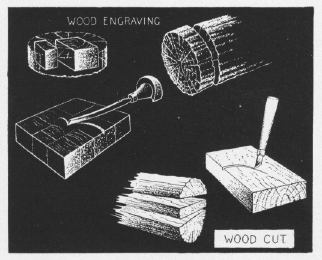The Woodcut Versus the Wood Engraving
Note: (Click images to pop-up enlargements.)
THE THREE ILLUSTRATIONS on this page present an interesting comparison between the woodcut and wood engraving, notwithstanding their reduction in size and reproduction by photo-mechanical processes.
The woodcut, wood engraving and linoleum cut all belong in the relief group of original printmaking as distinct from the intaglio and planographic groups. Relief prints in general are printed from a flat surface in which the white patterns in the design have been removed by knife or graver, leaving the black patterns standing in relief to receive the ink 'film' and produce the print. The best illustration familiar to everyone is to cite the similarity of the rubber stamp to the relief block - each gains its final print from the same circumstance. Now examine the illustrations and see how effectively each artist has arrived at his final result by using blacks and whites in combination, thereby creating a convention which produces pictorial illusions. This truism is common to all relief prints whichever surface the artist elects to work on, whether his work is broad or delicate, whether cut by knife or gouge, or engraved with a burin. These common factors among relief prints are mentioned first, for it is regrettably true that many people have the idea that if a relief print is essentially linear, it is therefore a woodcut; that if it contains 'white line' passages, it must be a wood engraving. What actually determines whether a particular relief print is a woodcut or wood engraving is not its manner of execution, but the knowledge of which surface was used - if produced from endgrain wood, it is a wood engraving; if cut on plankwise wood, it is a woodcut. Careful study of this drawing by Paul Landacre will explain these two surfaces, graphically.

The Harry Cimino wood engraving, reproduced about half size of the
original print, was designed as a frontispiece for a book on game
fishing. Notice how linear and therefore typographically appropriate
it is. In manner, it recalls the early Renaissance woodcuts, which
were made to print and harmonize with the type; yet, actually, it is
a wood engraving, solely because the artist elected to engrave its
simple pattern on an end-grain block. Notice the variety of lines
Cimino has used and how suggestive of detail he has been throughout
his entire composition.

The wood engraving by Kevin O'Callahan was made as an independent
print, in which the three-dimensional aspect of his subject has been
successfully exploited by a subtle and consistent rendering of
volumes, planes and surfaces. Here the artist seems to have chosen
just the right medium to secure his desired effect. The end-grain
block permitted the artist to make delicate white lines easily with
the graver in the shadow areas of his design, which have produced a
striking spaciousness consistent with the scale and character of his
subject. This print has been honored by two print awards and has been
exhibited widely throughout the country.

The woodcut by Fiske Boyd presents a striking contrast to the wood
engravings. In the first place, the artist has taken advantage of the
grain of his plankwise block, so that it shows in the print as a
series of vertical white lines, in the black patterns. This subtle
grain effect would undoubtedly have been obliterated had the block
been subjected to mechanical press printing, but Mr. Boyd prints his
blocks by hand in the Oriental fashion of burnishing, which requires
a minimum of ink and scarcely exerts any pressure on the block. This
artist is one of the few Americans who use a knife exclusively in the
making of woodcuts; the majority favor gouges, similar to those used
by the woodcarver, except that they are made about the same length as
the graver and are set in handles, as illustrated in Landacre's
diagram.
The main difference between the effect produced by the knife and gouge is one of 'edge' character. Also the knife takes more patience to master and much longer to produce the same amount of cutting as a gouge&emdash;for where the gouge, either the U-shape or V-shape, removes a trench of wood at one stroke, it requires at least two incisions of the knife to effect the same result. Knife work usually produces 'edges' which are more angular and more cleanly cut than gouge work. This character appears throughout the Boyd woodcut, giving it a very decorative flavor.
While all three printmakers have employed conventions in their designs, Boyd has introduced more abstract forms than Cimino or O'Callahan. Boyd's woodcut is a perfect example of a woodcut in which white and black lines have been combined, and where the white pattern (frequently regarded by the conservative woodcutter as a negation) is as active and important as the black pattern. Special attention is called to the painter-like character of Fiske Boyd's woodcut. For it is interesting to see that in Harry Cimino's print its character was effected by its use as a book decoration, and that in Boyd's woodcuts there is a plastic quality derived from his long experience as a painter.
